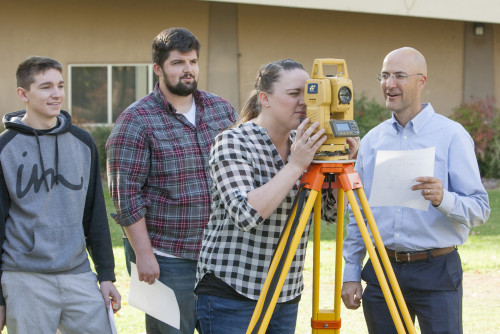Geographic Information Systems Certificate
Certificate | SC Program: CT.3449
The Geographic Information Systems (GIS) Certificate at Shasta College provides students with the knowledge and skills needed to apply principles, methods and tools of geographic information systems (GIS). Students develop foundation principles of maps, geographically referenced data, imagery and global positioning systems. GIS fundamentals are taught, both in conceptual and practical terms. Students learn the design of geographic databases and the capture of data using global positioning systems (GPS) and remotely sensed imagery. Spatial analysis skills are developed, from basic geographic inquiry through more complex analysis using GIS overlays and models. Students learn the principles and practice of remote sensing and image processing for integration with GIS and GPS. Maps are designed and implemented for output in hardcopy and digital formats. Worksite learning allows students to gain GIS workplace experience and to develop contacts among the community of GIS professionals. Successful students will have strong computer and critical thinking skills. Refer to http://www.shastacollege.edu/gis for more information.
This certificate is approved through the California Community College Chancellor’s Office. Upon satisfactory completion of all certificate requirements and filing an application for graduation with Admissions and Records, the student’s transcript will reflect completion of this certificate.
Program Outcomes:
- Explain and summarize key GIS concepts, applications and societal implications.
- Perform GIS data acquisition, capture, editing, and attributing.
- Manage GIS data through file management, database design, georeferencing and
conversion. - Perform GIS analysis using queries, overlay functions, and models.
- Produce maps that demonstrate effective communication, design aesthetics,
application of GIS tools and use of cartographic standards. - Effectively engage with community through projects, volunteer activities, user
meetings and worksite learning.



Choose your path
Map your education by viewing the program map for the degree or certificate you’re interested in earning below. Meet with a counselor to create your official comprehensive education plan.
A program map shows all the required and recommended courses you need to graduate and a suggested order in which you should take them. The suggested sequence of courses is based on enrollment and includes all major and general education courses required for the degree.
Fall Semester, First Year
9 Units TotalThis course covers the theory and practice of geographic information systems (GIS). Students learn essential GIS procedures for data viewing, acquisition, manipulation, geographic referencing, and map creation. GIS data types, properties, database operations and applications are covered. Basic methods of GIS analysis are also included. This course focuses on the ArcGIS software platform, employing both desktop and online products. This course may be offered in a distance education format.
Spring Semester, First Year
10 Units TotalThe Geographic Information Systems(GIS) Work Experience Education course allows the student to gain on-the-job experience through employment/volunteerism at an approved GIS job site that is acquired by the student and related to the student's major. A faculty member supervises all WEE courses to ensure that the work experience is of educational value. The course stresses good work habits and meeting of competencies through actual on-the-job performance. A student may repeat this course since course content varies and skills are enhanced by supervised repetition and practice. A maximum of 14 units may be earned in a single semester.
Please see a counselor to discuss options for meeting general education requirements for transfer to California State Universities (CSU) and/or University of California (UC) campuses, as well as any specific additional courses that may be required by your chosen institution of transfer.
*Alternative Courses: Please see a Shasta College counselor for alternative course options. You can also view the following to find other courses to meet degree/certificate requirements:
- California State Universities – General Education
- IGETC – Intersegmental General Education Transfer Curriculum
Contact Us for More Information
Counseling & Student Services
Contact InfoAcademic/Instructional Division Office
Science, Language Arts & Mathematics (SLAM)
Contact InfoStart Your Future at Shasta College
We are dedicated to helping you reach your educational and career goals. To begin your journey, apply for admissions today!
